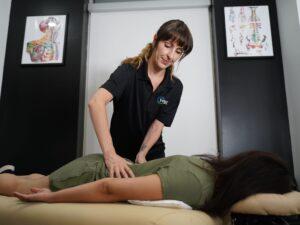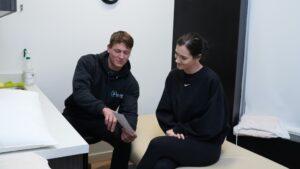Ever felt a throbbing headache come on after a long day hunched over your desk, or a tense neck stiffen up just before a migraine hits? You’re not alone. Back pain and headaches are a frustrating duo that often appear together. But why is this, and what can you do about it?
The connection between your spine and headaches
Your spine, particularly the upper cervical vertebrae (neck), houses a network of nerves that travel throughout your body. When this area experiences tension, misalignment, or inflammation, it can trigger headaches in various ways.

Common headache’s from back pain
Muscle Tension Headache: Our daily lives are often riddled with poor posture, stress, and repetitive movements. All these factors can lead to tightness and trigger points in the upper back and neck muscles. This tension can then radiate upwards, causing a dull, achy pain around your temples or forehead – a classic tension headache.
Cervicogenic Headaches: These headaches originate from the cervical spine (neck) and often feel similar to tension headaches. However, they might also be accompanied by neck stiffness, dizziness, or pain behind the eye. Cervicogenic headaches arise when dysfunction in the joints, muscles, or nerves of the neck irritates the nerves that supply sensation to the head.
Pinched Nerve in Your Neck (Osteoarthritis, Degenerative Disc Disease): Osteoarthritis and degenerative disc disease are age-related conditions that can lead to narrowing of the spinal canal in your neck. This narrowing, called spinal stenosis, can put pressure on the nerves exiting the spine. This pinched nerve can cause radiating pain, numbness, and weakness in your arm, but it can also trigger headaches!
Occipital Neuralgia: This less common headache type involves inflammation of the occipital nerves, located at the base of your skull. The pain from occipital neuralgia is typically sharp, shooting, and located behind the head or radiating to the forehead. Triggers for occipital neuralgia can include poor posture, muscle tension, and even a previous injury to the neck.
Understanding the connection is key
Knowing how your back pain might be linked to your migraine or chronic headache is empowering. Here’s what you can do to to help with pain management:
- Improve Your Posture: Practice sitting tall with your shoulders relaxed and ears aligned over your shoulders. Invest in an ergonomic chair and workstation setup to curb any poor posture throughout the day.
- Stretch and Strengthen: Regular neck and upper back stretches can help alleviate muscle tension and improve flexibility. Physiotherapists can design a personalized program to address your specific needs. Strengthening exercises for your core and upper back muscles will also contribute to better spinal alignment and support.
- Manage Stress: Stress is a major contributor to muscle tension and headaches. Relaxation techniques like deep breathing exercises, meditation, or yoga can be incredibly beneficial.
- Consider Manual Therapy: Physiotherapists can use manual therapy techniques like massage, joint mobilization,and trigger point therapy to release muscle tension and improve joint mobility in your neck and upper back. This can significantly reduce pain and prevent future headaches.
- Maintain a Healthy Lifestyle: Getting enough sleep, staying hydrated, and eating a balanced diet all play a crucial role in overall health and well-being. These habits can help reduce inflammation and improve your body’s ability to heal.
When to seek professional help
While some headaches and back pain may be temporary and manageable with self-care strategies, it’s important to seek professional help if:
- Your headaches are severe or persistent.
- You experience any neurological symptoms like numbness, weakness, or dizziness alongside your headache.
- Your back pain radiates down your leg or causes difficulty walking.
- Self-care measures don’t provide relief within a few days.
Manage your headache and back pain at Synergy Rehab
Don’t let neck pain, back pain, and a nagging headache ruin your day. Take control of your health, listen to your body, and consider our holistic approach to pain relief at Synergy Rehab.
We offer a team of qualified massage therapists, physiotherapists, and chiropractors who work together to create a personalized treatment plan for you.
Massage Therapy: Our registered massage therapists can use various techniques to target tight muscles in your upper back and neck, promoting relaxation, improving circulation, and reducing pain that might be contributing to your headaches.
Physical Therapy: Synergy Rehab’s physiotherapists will assess your posture, joint mobility, and muscle strength to identify any underlying issues in your spine. They will then design a program of therapeutic exercises and manual therapy techniques to improve flexibility, strengthen core and upper back muscles, and restore proper spinal alignment. This holistic approach can significantly reduce pain, prevent future headaches, and improve your overall well-being.
Chiropractic Care: For some patients, chiropractic adjustments may be beneficial. Our chiropractors use gentle manipulations of the spine to improve joint mobility and function. This can help alleviate pain and inflammation in the neck, potentially reducing the frequency and intensity of headaches related to spinal misalignment.
By combining these different treatment modalities, we can address the root cause of your back pain and headaches, offering you long-term relief and a path to a healthier, pain-free you. Contact Synergy Rehab today and schedule a consultation to discuss how we can help you with headache disorders and chronic pain.








